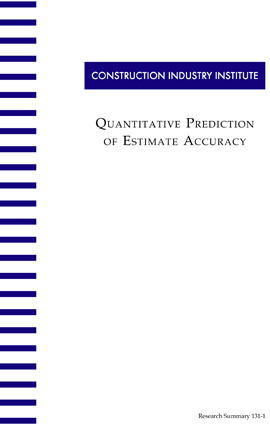
Qualititative Prediction of Estimate Accuracy
For engineering and construction projects, accurate early cost estimates are extremely important to the sponsoring organization and the engineering team. For the sponsoring organization, early cost estimates are often a basis for business unit decisions.
The accuracy of an early estimate depends on four determinants: who was involved in preparing the estimate, how was the estimate prepared, what was known about the project, and other factors considered while preparing the estimate. To measure the impact of these four determinants with respect to estimate accuracy, the CII Improving Early Estimates Research Team developed the Estimate Score Program (ESP), a software tool that evaluates 45 elements, organized in four divisions. The ESP software was developed to automate the scoring procedure and to assess accuracy and predict contingency based on historical cost data. The software and user’s manual are published by CII on a compact disc and publication (Implementation Resource 131-3, Estimate Score Program Guide [archived]). The research team also produced Implementation Resource 131-2, Improving Early Estimates: Best Practices Guide.
The ESP tool enables the business unit and the team to make better decisions based on statistically valid information. It improves team alignment by providing a better understanding of the estimate and the factors that can affect the accuracy of an early estimate.
This summary focuses on the research team’s development of the ESP tool (CII Implementation Resource 131-3). The tool itself is a credible, readily usable software that has the potential to improve not only early estimates, but project team alignment as well.
The factor analysis and regression analysis performed in development of the ESP identified eleven factor groups with the most impact on estimate accuracy.
The figure below describes the eleven factors in order of significance. The most significant factor, basic process design, accounts for 25% of the estimate score therefore concludes that a comprehensive and definitive process design is critical to the accuracy of early estimates. Basic process design includes process flow sheets, heat and material balance, project schedule, capacities, equipment list, and P&IDs as the highest factors elements. (RS131-1, p. 9)
This is the second factor of significance in the accuracy of early estimates. Extensive analysis of historical project data revealed that there is a positive correlation between estimated and actual total installed cost based on issues related to the team’s skills and experience, the estimating procedures, and scope definition. It was concluded in situations where scope definition is limited, project teams with good established estimating practices and experienced personnel were able to prepare accurate early estimates.
The figure below illustrates the hypothesis RT-131 developed regarding the positive impacts of team experience and good procedures with various levels of scope definition. (RS131-1, p. 25)
Graphic showing effect of the team experience and procedures on estimate quality.


